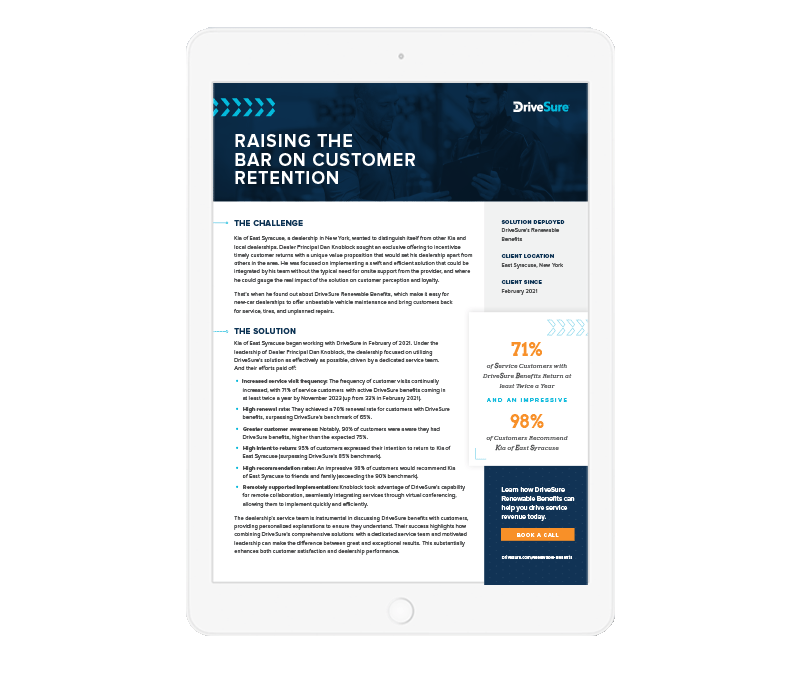Effective training in a dealership isn’t just about ticking boxes; it can be a major game-changer for safety, communication, and customer retention. When dealers focus on making training a regular, evolving part of their team, the benefits are huge.
It’s about more than just the newbies learning the ropes; it’s about creating a continually improving team that instinctively knows how to keep the workplace safe, and talk to both customers and each other in a way that benefits customers and keeps them coming back for more.
In other words, a well-trained team can turn a good service department into a great one, with a strong flow of loyal customers coming through the door. So what should service departments focus on training for?
Enhancing communication within the service department
Effective communication among service department staff is essential for operational efficiency and customer satisfaction. Regular training sessions can focus on improving internal communication, from the nuances of conveying technical information to the importance of transparent dialogue about challenges.
Establishing clear procedures for handling customer requests and grievances ensures consistency and reduces misunderstandings. Follow-up discussions to review new policies and gather feedback can help fine-tune these communication strategies, making the service process smoother for both staff and customers.
Starting points: Consider incorporating role-playing scenarios to practice customer interactions, and develop communication toolkits that include key phrases and technical explanations for consistency.
Properly following up with customers
Follow-up communication with customers is an often-underutilized tool in nurturing a positive service experience. Training staff to follow a standardized follow-up procedure ensures consistency in how customers are engaged after their visit. Implement a strategy that includes regular service reminders and personalized messages, as this can significantly enhance the customer’s perception of the dealership’s commitment to their satisfaction.
By coaching staff to use a variety of channels, such as phone calls, emails, and text messages, you can cater to different preferences, making customers feel heard and valued. This multi-channel approach not only aids in addressing any unresolved issues promptly but also keeps the dealership at the forefront of the customer’s mind.
You can also reduce the amount of communication training necessary in the first place, by adopting the right processes and automations.
For example, incorporating visually engaging reminders — like dealership-branded materials or service prompts that customers can easily access through QR codes — adds a layer to traditional follow-up methods and keeps your brand front and center.
Similarly, by automating parts of the customer communication process, dealerships can ensure that no customer is overlooked and that each receives timely, relevant updates regarding their vehicle’s maintenance needs.
This not only strengthens the customer-dealership relationship, encouraging repeat business and loyalty, but also demonstrates a level of professionalism and attention to detail that customers appreciate. And each automation reduces the number of tasks your staff needs to remember and be trained for.
Starting points: Provide training on CRM software and a maintenance marketing system to automate and personalize customer follow-ups. Implement a feedback system for monitoring the effectiveness of follow-up communications.
See how one Kia dealership increased service visit frequency by 45%.
Elevating customer service quality
When it comes to customer service, the goal is to not only resolve issues but to do so in a manner that makes each customer feel valued and respected. This starts with active listening, understanding the customer’s concerns, and offering solutions that meet their needs. It’s about more than just the transaction; it’s about building a relationship.
Applying sales team skills like these toward effective customer interactions can provide an effective way to enrich the service experience. This approach not only addresses immediate needs but also lays the groundwork for a lasting connection, encouraging customers to return.
Consider incorporating “unreasonable hospitality” by erring on the side of overdelivery for all your customers, setting a high standard that sets you apart. This type of training for service advisors on managing customer needs helps reduce customer anxiety, especially at critical points.
It’s worth mentioning that while customer service advice is everywhere, not everyone is willing to implement systems that make sure that advice is applied effectively, such as introducing a customer feedback loop, where you regularly gather feedback from customers to improve customer services practices.
Starting points: Run empathy and active listening workshops to improve understanding of customer concerns. Regularly solicit customer feedback to improve service at critical touchpoints.
Improving safety in the service department
While it’s crucial to efficiently address customer needs, the well-being of technicians and staff cannot be overlooked. Integrating safety into the daily routine involves more than just adhering to protocols; it’s about fostering a culture where safety is ingrained in every action. Encouraging staff to promptly address potential hazards, ensuring the workspace is free from clutter, and mandating proper attire are foundational steps.
Additionally, restricting access to service areas to authorized personnel only reinforces a secure environment. Regular safety briefings and an open dialogue about concerns can further enhance this culture, keeping safety at the forefront of everyone’s mind.
Starting points: Implement regular safety audits with staff participation to reinforce safety protocols.
How more effective training can drive substantial revenue
Consider one instance of how strategic training on areas like communication can have a substantial impact on dealership revenue and customer loyalty:
In February of 2021, Kia of East Syracuse partnered with DriveSure. Dealer Principal Dan Knoblock spearheaded an initiative to maximize the effectiveness of DriveSure’s offerings, focusing on in-depth communication training for his service team. This training empowered the team to effectively and consistently communicate the benefits of DriveSure to vehicle owners, both during service visits and follow-up.
These training efforts led to remarkable outcomes. First, the dealership witnessed a substantial increase in the frequency of customer service visits: by November 2023, 78% of customers with active DriveSure benefits were visiting at least twice a year, a sharp rise from 33% in February 2021.
This success was mirrored in their renewal rate, which hit 70%, outperforming DriveSure’s 65% benchmark. Moreover, the dealership excelled in customer satisfaction metrics, with 95% of customers indicating their intention to return, and an impressive 98% saying they would recommend Kia of East Syracuse to friends and family.
This story demonstrates how effective training and the deployment of DriveSure’s solutions can elevate customer engagement and retention. The dealership’s approach showcases the power of trained and motivated staff in driving dealership revenue and enhancing the customer service experience.
To learn more about how they did it, read the full client profile today.
Raising the Bar on Customer Retention
Discover how Kia of East Syracuse increased service visit frequency by 38%.


